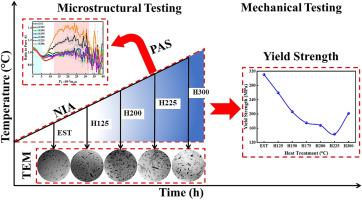Effect of vacancy-mediated precipitation on the microstructure and mechanical properties of 7075 aluminum alloy
IF 5.5
2区 材料科学
Q1 MATERIALS SCIENCE, CHARACTERIZATION & TESTING
引用次数: 0
Abstract
The non-isothermal aging (NIA, 125–300 °C) response of 7075 Al alloy was tracked to assess vacancy-solute interactions on precipitation kinetics and their resulting impact on the mechanical properties. Positron Annihilation Spectroscopy (PAS) revealed that solution heat treatment (SHT)-induced monovacancies enhance solute diffusion, shifting positron trapping from V-Mg to V-Zn, and ultimately forming V-Mg/Zn-promoting complexes that facilitate precipitate nucleation at lower aging temperatures (125–200 °C). At higher temperatures (225–300 °C), the effects of vacancies weakened as precipitates absorbed vacancies, thereby reducing diffusion and yielding finer precipitates. Microstructural analyses (XRD, SEM, and TEM) revealed the following precipitation sequence: the formation of fine Al2Cu, GP zones, and η’ precipitates in the early aging stages and then subsequent coarsening of these precipitates between 125 and 200 °C; and the dissolution of GP zones, slight refinement of η’, and the formation of stable η precipitates at 225–300 °C. These microstructural transformations had a profound impact on mechanical performance, with peak strength observed during early-stage aging (YS: 310 MPa, HV: 244), followed by a decline to its lowest point at 225 °C (YS: 143 MPa, HV: 147) and a partial recovery at the final aging temperature (YS: 201 MPa, HV: 181). This study helps optimize heat treatment and thereby enhance the performance of 7075 aluminum alloy for aerospace applications by exploring vacancy and precipitation dynamics.

空位介导析出对7075铝合金组织和力学性能的影响
研究了7075铝合金的非等温时效(NIA, 125 ~ 300℃)反应,评价了空位-溶质相互作用对析出动力学的影响及其对力学性能的影响。正电子湮灭光谱(PAS)表明,固溶热处理(SHT)诱导的单空位增强了溶质扩散,将正电子捕获从V-Mg转移到V-Zn,最终形成促进V-Mg/ zn的配合物,有利于在较低时效温度(125-200℃)下析出形核。在较高温度下(225-300℃),空位的作用减弱,析出相吸收空位,从而减少扩散并产生更细的析出相。微观组织分析(XRD、SEM和TEM)表明:在时效早期形成细小的Al2Cu、GP区和η′相,在125 ~ 200℃之间逐渐粗化;在225 ~ 300℃,GP区溶解,η′细化,形成稳定的η相。这些微观组织的转变对合金的力学性能产生了深远的影响,其强度在早期时效时达到峰值(YS: 310 MPa, HV: 244),随后在225℃时降至最低点(YS: 143 MPa, HV: 147),在最终时效温度下部分恢复(YS: 201 MPa, HV: 181)。本研究通过探索空位和沉淀动力学,有助于优化热处理工艺,从而提高7075铝合金的航空航天应用性能。
本文章由计算机程序翻译,如有差异,请以英文原文为准。
求助全文
约1分钟内获得全文
求助全文
来源期刊

Materials Characterization
工程技术-材料科学:表征与测试
CiteScore
7.60
自引率
8.50%
发文量
746
审稿时长
36 days
期刊介绍:
Materials Characterization features original articles and state-of-the-art reviews on theoretical and practical aspects of the structure and behaviour of materials.
The Journal focuses on all characterization techniques, including all forms of microscopy (light, electron, acoustic, etc.,) and analysis (especially microanalysis and surface analytical techniques). Developments in both this wide range of techniques and their application to the quantification of the microstructure of materials are essential facets of the Journal.
The Journal provides the Materials Scientist/Engineer with up-to-date information on many types of materials with an underlying theme of explaining the behavior of materials using novel approaches. Materials covered by the journal include:
Metals & Alloys
Ceramics
Nanomaterials
Biomedical materials
Optical materials
Composites
Natural Materials.
 求助内容:
求助内容: 应助结果提醒方式:
应助结果提醒方式:


